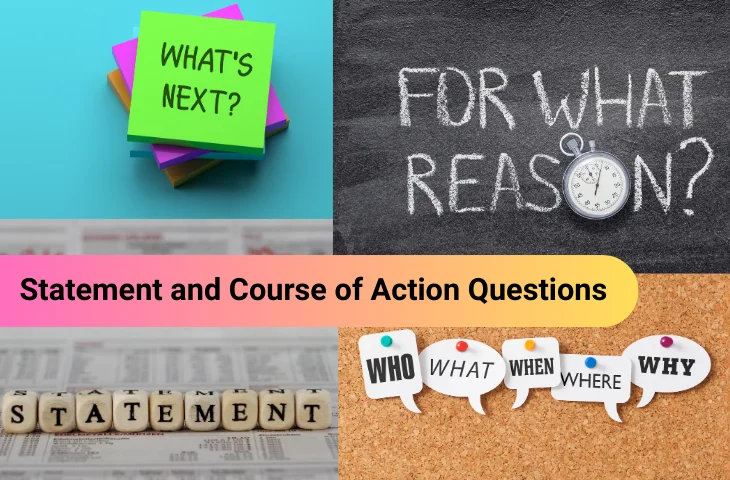Statement and Course of Action reasoning is a vital topic in competitive exams like SSC, IBPS, SBI PO, and RRB. It tests your ability to make logical decisions based on given statements. In this blog, we have provided short notes, key tricks, formulas, solved questions, common mistakes, and tips on statement and course of action reasoning.
What Is Statement and Course of Action in Reasoning?
Statement and Course of Action questions present a situation (statement) followed by possible actions. Candidates must judge which action logically follows.
Why it appears in exams:
These questions evaluate decision-making, logical thinking, and the ability to analyze situations quickly.
Skills required:
- Logic and reasoning
- Analytical thinking
- Decision-making
- Visualization of cause-effect
Why Is Statement and Course of Action Important in Competitive Exams?
Statement and Course of Action questions test judgment and reasoning skills, crucial for government and banking exams.
| Exam | No. of Questions | Difficulty |
| SSC CGL / CHSL | 1–2 | Easy |
| IBPS PO / SBI PO | 1–2 | Moderate |
| RRB NTPC / Group D | 1 | Easy |
| State PSC / Police | 1–2 | Moderate |
Get the details about the upcoming government exams and start your preparation TODAY!
Statement and Course of Action Reasoning Short Notes
Short notes help revise faster. Some of the key concepts for last minute revision are as follows:
| Concept | Explanation |
| Statement | Situation or scenario provided |
| Course of Action | Possible decisions or steps following the statement |
| Follows/Does Not Follow | Determines validity of action |
| Strong/Weak Action | Strong: necessary; Weak: optional or irrelevant |
Quick Revision Summary
Some details on Statement and Course of Action reasoning suitable for last-minute revision are as follows:
| Concept | Details |
| Strong Action | Directly follows from statement |
| Weak Action | Does not logically follow or unnecessary |
| Avoid Assumptions | Only consider facts given |
| Stepwise Analysis | Check each action individually |
| Elimination | Remove irrelevant or contradictory actions |
| Logical Mapping | Visualize cause-effect relationships |
What Are the Types of Statement and Course of Action Questions in Reasoning?
In reasoning tests, Statement and Course of Action questions assess your ability to analyze a given situation and decide the most appropriate and practical action. The type of question usually depends on the nature of the statement, which can describe a problem, a neutral fact, or data-driven scenario.
1. Problem-and-Solution Based
This is the most common type. The statement presents a specific problem that requires a practical and logical step to resolve or mitigate it.
Example:
Statement: “A large number of students in the city were caught using unfair means during the board examinations.”
Logical Course of Action: Punish the students involved while improving invigilation and security for future exams. Extreme or unrealistic actions, like banning all students, are invalid.
2. Fact-and-Improvement Based
Here, the statement highlights a neutral fact or situation. The correct course of action focuses on improving the situation or deriving a positive outcome.
Example:
Statement: “Retired professors can offer valuable insights if invited to deliberate on restructuring the organization.”
Logical Course of Action: Management should involve experienced retired faculty for systematic restructuring.
Check out 100 Reasoning Questions with Solution for IBPS RRB
3. Data-Driven or Policy-Related
These questions use statistical data, reports, or policies as statements. The appropriate action involves logical administrative or policy decisions based on the provided information.
Example:
Statement: “The meteorological department has forecast less rainfall during next year’s monsoon.”
Logical Course of Action: Advise farmers to prepare by selecting suitable crops or irrigation methods. Actions assuming pre-arranged solutions are illogical.
Key Principles for Evaluating a Course of Action
These principles help you pick actions that make sense, are practical, and effectively address the situation.
- Logical and Practical: The action must be feasible and realistic, avoiding extreme or vague steps.
- Focus on the Core Problem: The action should directly address the main issue of the statement.
- Immediate vs Long-Term Solutions: Determine whether the problem requires short-term intervention, long-term planning, or both.
- Avoid Creating Bigger Problems: A proper course of action should resolve or reduce the issue without causing further complications.
Also Solve Statement and Assumption Questions Based on RRB NTPC
How to Approach Statement and Course of Action Questions
A systematic approach is essential while solving questions based on Statement and Course of Action. First, read the statement carefully, then analyze each action, focus on practical solutions, and check whether it solves or improves the situation.
- Understand the Statement: Read the statement carefully to fully grasp what the situation or problem is about.
- Analyze Each Action: Look at each suggested action and think about whether it’s realistic, effective, and relevant to the problem.
- Seek Practical Solutions: Focus on steps that can actually be implemented and make a real difference.
- Check the Outcome: Consider whether the action will truly solve the problem, reduce its impact, or improve the situation in a meaningful way.
Practice all questions based on Logical Reasoning
Statement and Course of Action Formulas for Reasoning
Reasoning “formulas” are mental models or shortcuts:
- Follow only the given facts
- Identify strong vs weak actions
- Ask: Does the action solve the problem?
- Eliminate irrelevant options first
- Visualize outcome if action is taken
Take a free SBI PO Previous Year Paper Test now!
Statement and Course of Action Tricks for SSC CGL and Other Exams
Some of the short tricks to solve questions based on this topic are as follows:
- Use a stepwise elimination method
- Start from the end of the statement
- Map indirect relations with cause-effect arrows
- Focus on keywords like “should,” “must,” “necessary”
- Avoid assumptions beyond the given facts
Solved Statement and Course of Action Questions from 2024–25 Exams
- Exam: SSC CGL 2024 Tier 1 – Memory-Based
Statement: Government decided to reduce fuel prices.
Course of Action:
A. Transport costs will reduce. (Ans)
B. All taxes will be abolished.
Explanation: Option A follows logically; Option B assumes extra facts. - Exam: IBPS PO 2024
Statement: Bank increases interest rate on deposits.
Course of Action:
A. More people will save money. (Ans.)
B. Inflation will decrease immediately.
Explanation: Only A logically follows; B is an assumption. - Exam: RRB NTPC 2024 – Memory-Based
Statement: School introduces online attendance system.
Course of Action:
A. Students’ attendance will be tracked digitally. (Ans.)
B. Exams will become easier.
Explanation: Only A is a direct result.
Check out all the details about Analytical Reasoning
Statement and Course of Action Concepts for Bank Exams
Bank exams often include coded, symbol-based, or logic-tree variations. Example:
Statement: “Customer complaints are increasing.”
Actions:
- Investigate complaints (Ans.)
- Close the branch
Coded questions may use symbols like S1 (Statement 1) – A1 (Action 1), and you have to decide which actions follow.
Common Mistakes to Avoid while Solving Statement and Course of Action
Some of the common mistakes to avoid while solving questions statement and course of action are as follows:
- Assuming facts not in the statement – Only consider given information.
- Ignoring weak vs strong actions – Identify clearly.
- Reading too fast – Misinterpretation is common.
- Skipping elimination step – Leads to wrong options being selected.
- Overthinking – Focus on logical consequences, not extra assumptions.
Related Reasoning Topics to Explore
| Topics | Topics |
| Blood Relation Concepts | Floor Based Puzzle Short Tricks |
| Statement and Assumption Reasoning | Puzzle Reasoning Questions |
| Calendar Reasoning Strategies | Alphanumeric Series Patterns |
Aspirants, now you have a clear understanding of how to practice and solve Statement and Course of Action questions effectively. You can also enroll in Oliveboard Courses and learn from experienced faculty members to strengthen your preparation before appearing for the next competitive exam.
FAQs
Focus on identifying strong actions and eliminate weak or irrelevant ones.
No, only actions supported by the given statement should be considered.
An action that logically follows from the statement and addresses the issue.
Do not assume extra facts and distinguish between immediate and long-term actions.
Yes, focus on keywords, eliminate irrelevant options, and visualize outcomes.
- PNB LBO Syllabus and Exam Pattern 2025, Check Details
- PNB LBO Salary 2025, In Hand Salary, Perks, and Allowances
- Most Repeated Quantitative Aptitude Questions for SSC CHSL Tier 2
- Bank of Baroda LBO Group Discussion, Topic List, Complete Guide
- Bank of Baroda LBO LPT, State-wise Languages & Full Details
- Bank of Baroda LBO Interview Questions and Answers, Download FREE PDF

Hi, I’m Aditi. I work as a Content Writer at Oliveboard, where I have been simplifying exam-related content for the past 4 years. I create clear and easy-to-understand guides for JAIIB, CAIIB, and UGC exams. My work includes breaking down notifications, admit cards, and exam updates, as well as preparing study plans and subject-wise strategies.
My goal is to support working professionals in managing their exam preparation alongside a full-time job and to help them achieve career growth.
